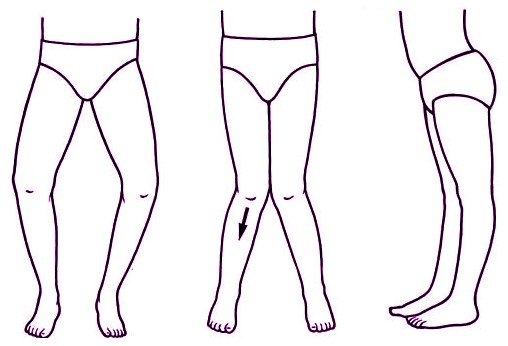Genu Recurvatum
Definition
This is a medical condition where the hyperextension of your knee is greater than five degrees. It is also referred to as back knee or knee hyperextension. It appears to occur more in females than it does in males. When this medical condition occurs it can cause stress in your posterior knee structures and your anterior cruciate ligaments (ACL) and possibly cause permanent damage of the joint. Having genu recurvatum could also cause other medical conditions such as knee osteoarthritis or knee pain. Genu recurvatum can be mild, moderate, or severe.
Types
There are three types of genu recurvatum which are:
- External rotary deformity (ERD) — this is when your foot remains in an equinovarus position when walking, which is the posture of a club foot. Your foot makes ground contact on the outer edge of your foot. This type of genu recurvatum is normally seen in a stroke patient whose foot movements are abnormal because of their abnormal pattern of muscle tone.
- Internal rotatory deformity (IRD) — this type is when you start with an abnormal gait in which your forefoot is rotated outward. This will cause you to compensate by overextending your knee and leading to this type of deformity.
- Non-rotatory deformity (NRD) — your ankle and foot are positioned normally with your knee being the primary abnormality. What causes this type of genu recurvatum is an injury that forces the hyperextension of your knee.
Symptoms
- Pain in your inner-leg portion of your knee called the medial tibiofemoral joint
- Pain in your outer back portion of your knee called the posterolateral ligamentous structures
- Extension gait pattern
- Pinching in the front of your knee
- Having difficulty in carrying out endurance activities
- Your knee can give way into hyperextension
Causes
Some of the causes of genu recurvatum can include:
- Misalignment of your ankle joint
- Knee injuries that involve hyperextension of your knee
- Excess laxity in your knee joint
- Postural habits
- Abnormal ankle and foot position when walking
- Knee joint instability
- Weakness in your quadriceps femoris muscle or hip extensor muscles
- Congenital/birth defect
- Connective tissue disorders
- Discrepancy in lower limb length
- Certain medical diseases such as muscular dystrophy, multiple sclerosis, and cerebral palsy
Diagnosis
To diagnosis genu recurvatum the physician uses magnetic resonance imaging (MRI) or x-rays along with gait analysis. These tests can also help to classify the type of genu recurvatum you have.
Treatment
It is important that you get a timely diagnosis of genu recurvatum and treat it promptly because if not it can lead to increased tissue damage. Any type of genu recurvatum deformity will place a strain on your knee and cause increasing joint deformity if you do not correct it and this deformity could become permanent.
- ERD — this can lead to increasing soft tissue damage as well as genu valgum of your knee, which is the medical terminology for knock knees. This is where your lower legs angle outward.
- IRD — this type produces a less-severe recurvatum and genu varum, which is the medical terminology for bow legs.
- NFD — this type produces increasing stress to the posterior soft tissue structures of your knee.
Treatment often requires physical therapy so the therapists will brace or tape the knee along with providing muscle balance correction, gait training, and proprioceptive training, which is training that is designed to increase your balance, agility, strength, coordination, and to help prevent further injuries.
If a person has IRD or ERD they will usually need fort orthotics to correct the positioning of their ankles. For the more severe type you may require a knee brace. Exactly which treatment would be used would depend on the severity and type of genu recurvatum you have. There are some cases of genu recurvatum that would require surgery to repair the damage to your knee.
Prevention
Because genu recurvatum may occur due to an injury or genetically it is not possible to prevent this from happening or having a recurrence of the deformity. Wearing braces or undergoing rehabilitation can help to limit the hyperextension of your knee joint.
